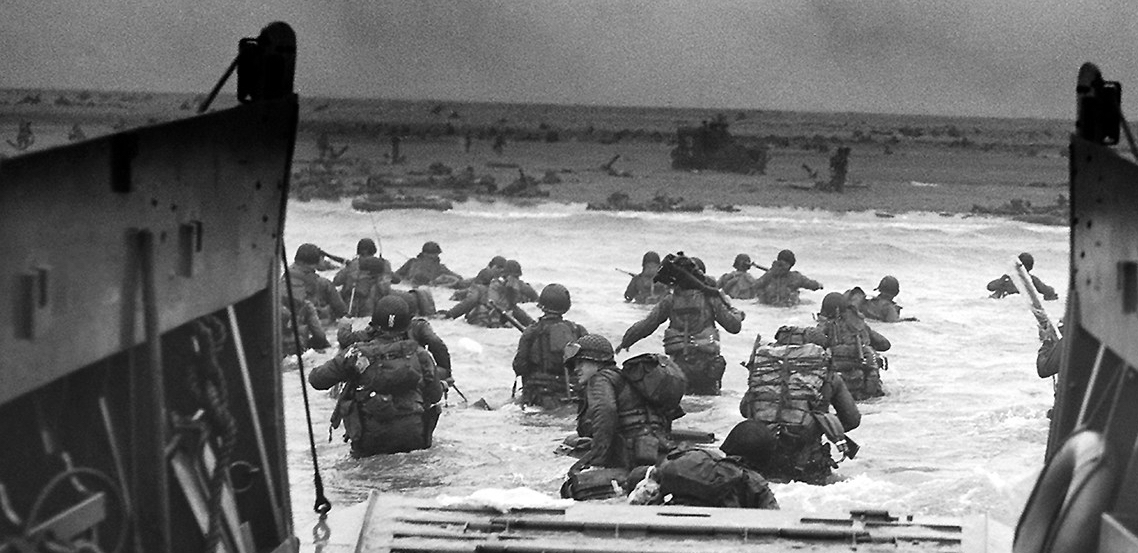
Respected artists deployed across the globe on assignment to Life Magazine during World War II to capture images of Americans at war. Among them was Peter Hurd, noted for his portraits and southwestern landscapes. In the late summer and autumn of 1942, he traveled to the United Kingdom to paint airmen of the 97th Bombardment Group, 8th Air Force.
Mr. Hurd spent a total of five months in England. At the end of his tour, he went home to New Mexico, where he completed the artwork you see on this page. Of the fliers who served as his subjects, Mr. Hurd later wrote:
They seem like a band of legendary heroes, although I know well that they themselves would scoff at such an idea. … They have the look of veterans, these youngsters in their late teens and early twenties. United in their supreme purpose, they have looked death in the face repeatedly and unflinchingly. They are invariably realists and know well the odds for and against their survival. But there is in them a will to endure – to endure beyond this struggle … (1)
The 97th was based in Northamptonshire, England at RAF Polebrook and RAF Grafton Underwood at that stage of the war. On August 17th, 1942, the group flew the first American strategic mission against occupied Europe. Twelve B-17 Flying Fortresses attacked a rail target near Sotteville-lès-Rouen, France and six hit a diversionary target on the coast.
Of that initial raid over Nazi-occupied France, historian Edward Jablonski wrote:
The two flights of Fortresses approached Rouen at 23,000 feet; visibility was excellent. There was little antiaircraft fire, but the green crews performed very well as they loosed their bombs at the target. Though it was a rather large target, the bomb patterns were good considering the crews were experiencing their first mission. (2)
RAF fighter squadrons provided a heavy escort for their American brothers, yet the raid was but a pinprick, a harbinger of the whirlwind to come. But the symbolism was undeniable. In his immortal speech to the House of Commons in the darkest hour of June 4th, 1940, Winston Churchill had told the British people:
… We shall never surrender, and if, which I do not for a moment believe, this island or a large part of it were subjugated and starving, then our Empire beyond the seas, armed and guarded by the British Fleet, would carry on the struggle, until, in God’s good time, the New World, with all its power and might, steps forth to the rescue and the liberation of the old.

With the early raids against German targets in France, the 8th Air Force answered Mr. Churchill’s soaring words. The road was long and hard, but the Americans were here, and Nazi Germany was about to feel the wrath of the new world. The Mighty Eighth would evolve into one of the most powerful war machines in history, but that was all in the future during those uncertain months of 1942.

Many gallant airmen flew on that first raid over Europe. Among them was Capt. Paul Tibbets, a squadron commander who piloted the lead Fortress. Three years later, he would lead his crew in Enola Gay to her mission with destiny over Hiroshima.

With Capt. Tibbets on that August day in 1942 was Col. Frank Armstrong, commander of the 97th Bombardment Group. He was another first-to-last airman. On August 15th, 1945, Armstrong would command the last heavy bombing raid of World War II. Brig. Gen. Ira Eaker also flew on the raid to Rouen in the B-17F Yankee Doodle. He was one of the architects of precision daylight bombing and went on the command the entire 8th Air Force.
One among the many heroes of World War II
As the aircraft commander of B-17 Birmingham Blitzkrieg (41-24413), 1st Lt. Thomas H. Borders flew in the first strategic raid on August 17th, 1942. The 97th Bomb Group was transferred to North Africa in the autumn of 1942. On a mission to Biskra, Tunisia on December 26th, 1942, his ship took a direct hit from a Flak round and exploded in mid-air. No parachutes were observed and the crew has been listed as missing since that day.


1st Lt. Borders and his crew are among the 3,724 World War II servicemen from the North African campaigns commemorated on the Tablets of the Missing at the North Africa American Cemetery in Tunisia. Even after more than 75 years, the Department of Defense lists more than 20,000 airmen as missing from the war.
Of the bomber crews who fought in the air during those early missions of 1942-43, some would survive, although the odds were stacked against them. The magical goal of 25 missions must have seemed far away as the big Fortresses lifted off the ground for that first mission on August 17th, 1942. Many airmen would die, and some are still listed as missing to this day. Other bore the scars of their battles against the Germans for the rest of their lives. All of them were trailblazers whose deeds should not be forgotten.
Never forget,
Mark
Notes:
- Quoted from the article “Peter Hurd – He Paints U.S. Airmen,” Life Magazine, page 66, February 15th, 1943.
- The cited passage is from page 92 of Flying Fortress – The Illustrated Biography of the B-17s and the Men who Flew Them by Edward Jablonski. Doubleday & Company, Inc., 1965.











